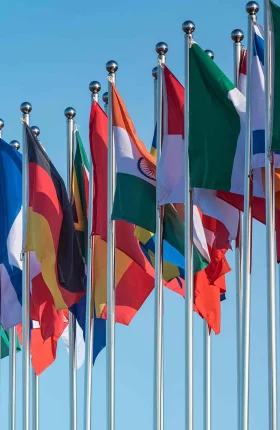As 2025 unfolds, the global business landscape is being reshaped by powerful forces that demand strategic foresight and the ability of companies to quickly adapt. The global trade system, regulatory frameworks, geopolitical alliances, security arrangements, and climate policies are all evolving rapidly.
Of the many forces of disruptive change at work, BCG has identified ten that we believe are the most critical for leaders to understand because they will significantly impact their businesses. They fall into three broad categories.
The first is what we call “unbalanced multipolarity”: the shift from a few centers of global power to a larger number of nations of unequal influence that are asserting themselves in the world. The America First vision of the Trump Administration, China’s economic transition, the rise of a confident Global South, and Europe’s “reckoning” are among the developments driving this trend.
A second category of disruptive forces involves the economic battlegrounds that these megatrends are creating. They include tectonic trade shifts, the race for technological supremacy, and the growth of economic nationalism. On top of these, business leaders must negotiate the global shocks that continue to affect business outcomes. These include armed conflicts, climate change that refuses to be ignored, and the polarization of societies.
1. America First
The administration of President Donald Trump, backed by a Republican-controlled Congress, has unveiled a series of measures it maintains will make the US safer, stronger, and more prosperous. The US is sharply raising tariffs on a wide range of goods imported not only from China but also from allies such as Canada, Mexico, and the EU to advance a number of goals, many of which aren’t directly related to trade. These moves have prompted many economists to cut their US growth forecasts. The Trump Administration aims to strengthen the US industrial base through deregulation and the reshoring of manufacturing jobs. It is pushing for an expansionist fiscal policy that includes deep corporate tax cuts. The administration maintains that this will boost investment in the US and accelerate reshoring.
The US is withdrawing from the Paris Agreement and taking steps to increase the use of and exploration for fossil fuels. It is restricting illegal immigration and seeking to restrict some pathways to legal immigration. And it is adopting a transactional approach to foreign and national security policy, even with its closest traditional strategic allies. This America First approach has profound implications for global supply chains, trade relations, and corporate decision making.
2. China’s Pivot
China is in the midst of a major economic transition as it confronts several structural challenges, including weak consumer spending, a struggling real estate sector, high public debt, and demographic shifts. Geopolitical tensions with the US complicate the nation’s path forward. Nonetheless, China will remain an attractive market for many businesses keen to seize a share of what promises to be significant growth for the foreseeable future.
China is pivoting along two dimensions. Externally, the government is working to ease the nation’s dependence on Western markets for its exports. Instead, it’s engaging more with the Global South and with its immediate neighbors as trade partners and investment destinations. Chinese companies are also investing in nations such as Morocco, Turkey, and Hungary in order to bypass US trade restrictions. Internally, China’s economy is shifting from heavy infrastructure and real estate investment as drivers of growth. The government is emphasizing leading-edge technology and advanced manufacturing. There is significant optimism regarding China’s leadership in areas such as electric vehicles and green energy systems, as well as in AI and quantum computing.
Stay ahead with BCG insights on international business
3. The Rise of a Confident Global South
As the Western-led world order fragments, economies in Asia, Latin America, Africa, the Middle East, and Southeast Asia (collectively known as the Global South) are gaining agency on the world stage—economically and diplomatically. These economies account for more than 60% of the world’s population and are projected to grow much faster than developed economies well into the future. They also have what the world needs: resources critical to global supply chains, young and expanding workforces, and growing consumer markets.
While highly diverse, the more than 130 nations of the Global South generally share a focus on economic growth and the deepening of international trade and investment ties with one another and the rest of the world. Many of these nations, which are very vulnerable to extreme weather events and rising sea levels, are taking a balanced and pragmatic approach to climate action. The nations of the Global South are also determined to remain multi-aligned. That leaves them unencumbered by the geopolitical agendas of the major powers and open for business with all.
Although the Global South lacks any formal organization, subsets of nations are linked together through various trade agreements and technology and economic partnerships. They are also making their voices heard through forums such as the G20 and the BRICS+, the latter signifying their willingness to retain economic ties with Russia and China. The Global South also faces challenges, such as the risk of getting caught in the middle of a US–China trade war or experiencing a popular backlash to their economic agendas if income inequality grows.
4. Europe’s Reckoning
The European Union faces a challenging decade as it grapples with economic stagnation, political fragmentation, and an urgent need to boost innovation and competitiveness. Geopolitically, Europe is in its weakest position in decades as ties with the US grow strained. Rising populism, shifting political alliances, and an erosion of social consensus across the bloc and within member states are making it harder to implement unified approaches to trade, defense, and industrial policies—slowing the EU’s response to international challenges. So are regulations that hobble companies’ ability to operate and build scale across the region. The EU lags the US and China in AI, digital transformation, and venture capital funding. A reliance on expensive imported energy hampers its industrial competitiveness.
The EU recognizes the urgent need to address its shortcomings. The 2024 report by former European Central Bank President Mario Draghi estimated that the EU will need up to an additional €800 billion in public and private investment to revamp the region’s industrial strategy, innovation capacity, and ability to scale up new companies. Several European nations have announced plans to significantly upgrade their defense capabilities in order to reduce their reliance on the US.
5. Tectonic Trade Shifts
Geopolitical and national-security considerations are fundamentally reconfiguring the future of trade. Although trade in goods is projected to keep growing by an average of 2.9% annually over the coming decade, the routes that goods travel will change dramatically. Businesses must anticipate these shifts and strategically position themselves to benefit from emerging trade dynamics.
We see several key tectonic shifts in international trade corridors. Economic and geopolitical fundamentals suggest that the US will continue to ease its engagement with China, and so far it’s unclear whether US tariffs against Canadian and Mexican imports will fundamentally change trade within North America. China is emerging as a stronger trade partner for the rest of the world. As mentioned above, the Global South is rising as a force in trade as it contributes more to industrial supply chains and moves beyond commodities to more sophisticated manufactured goods. The EU is becoming more reliant on long-standing Western trade partners and emerging markets such as Turkey and Africa as its trade with China largely stagnates.
6. The Race for Technological Supremacy
Competition for technological supremacy and the value chains of high-tech products is intensifying, with AI, quantum computing, and semiconductors at the center of geopolitical rivalries. This race for leadership has important implications for industrial competitiveness, national security, and the green energy transition. The US and China are the chief rivals in key technology battlegrounds. The US currently leads in AI development, but China is swiftly closing the gap and bringing low-cost large language models to market. The US is seeking to preserve its dominance in leading-edge semiconductors by imposing export restrictions on high-end chips and manufacturing technologies. In other areas, such as electric vehicles and green energy systems, Chinese companies have leapfrogged their Western competitors in applying advanced technologies to mass-produced products.
Other economies are investing heavily in homegrown technological capabilities to reduce their reliance on foreign players. The EU, for instance, is stepping up investments in semiconductor manufacturing, aerospace, clean technology, and biotechnology. India is also ramping up high-tech investment. In addition, nations are competing for access to lithium, cobalt, rare earth elements, and other critical minerals needed for high-tech devices, which is leading to geopolitical maneuvering in resource-rich regions.
7. Navigating Economic Nationalism
In a global environment marked by rising nationalism and great-power rivalry, countries are trying to gain economic advantages and reduce vulnerabilities. The role of the state in managing the economy is expanding and exacerbating pressure on public finances caused by demographic change and wider social challenges.
Governments worldwide are turning to economic statecraft not just to support domestic industries and supply chains. They’re competing for and politicizing foreign direct investment—both inbound and outbound—and deploying novel tools, such as newly established sovereign wealth funds, to achieve strategic goals. Trade policy measures normally designed to counter “unfair” trade practices are being used to advance foreign policy and national security agendas.
The US, for instance, is imposing high tariffs on China, Canada, Mexico, and other major trading partners as part of its America First strategy. The EU and other economies are likewise taking protectionist measures, making market access more complex for multinational businesses. By our count, the number of such economic interventions by governments has increased around six-fold globally over the past decade, to around 3,000 annually.
For companies, growing economic nationalism is complicating global sourcing strategies and increasing the uncertainty for investors and private companies caused by frequent changes in regulations and investment incentives. These uncertainties risk delaying decisions on large capital expenditures. And many business leaders who came of age during the high tide of free trade and multilateral institutions lack the experience to navigate increasingly complex trade compliance. Economic nationalism also has macroeconomic implications. One consequence of the shift in focus from efficiency to resilience could be slower growth. It is prompting nations to take on higher debt loads, is projected to increase inflation, and is creating uncertainty over interest rates and the role of the US dollar. It will also force governments to make fiscal tradeoffs that can affect a range of domestic policies.
8. Evolving Conflicts
The number of active and potential hotspots is growing around the world. Their complexity is rising as well, owing to a greater range of actors. In addition to Ukraine and Gaza, there is the recent military escalation between India and Pakistan and growing ethnic violence in places like Sudan. What’s more, frozen conflicts can quickly become hot again. In addition to the direct, physical risks to personnel and operations, sanctions and countersanctions stemming from these conflicts are disrupting businesses. Increased militarization in the South China Sea and the Taiwan Strait is raising tensions in Asia. The US, Canada, and Mexico are deploying more security forces to their borders to deter illegal immigration and drug smuggling, while the US is sending aggressive signals toward Panama and Greenland. Conflicts could also expand to new theaters, such as the Arctic and outer space.
Even if geopolitical dynamics allow some larger conflicts to be dialed down, they are likely to continue in hybrid ways, such as through cyber and physical attacks against organizations and critical infrastructure. The potential for disruption to supply chains, global operations, and energy security, therefore, will remain high and lead to a more complex regulatory environment.
9. Climate Refuses to Be Ignored
The need to adapt to and mitigate the impact of extreme weather events and rising sea levels driven by climate change continues to reshape global business. Many nations, particularly several emerging markets, remain vulnerable to extreme climate events, which are projected to have a significant impact on GDP. And because the business case is clear, we believe that economically viable and competitive low-carbon energy, technologies, and supply chains technologies will continue to thrive.
Green investment is still accelerating around the world. The EU leads the charge in deploying carbon-pricing mechanisms and maintaining subsidies for renewable energy. China continues to invest heavily in order to lead in the manufacture of green energy systems. In the US, support for renewable energy and manufacturing plants producing green products remains strong in certain states.
More importantly, the business case for low-carbon solutions remains strong. Solar and onshore wind power are now very cost competitive in the US with gas, geothermal, coal, and nuclear. What’s more, extreme weather events and the scarcity of resources such as water are risks that companies cannot ignore, particularly in industries such as agriculture, real estate, and logistics that are highly exposed to environmental disruption. Over the longer term, companies will remain under pressure to adopt more resilient business models.
10. Polarized Populations
Just as old geopolitical alliances are fragmenting, so are societies. Democratic institutions are under strain as political polarization and distrust in governments, media, and corporations intensify. Populist movements are gaining traction in major economies. Social media, which has given everyone a voice (whether or not based on fact) is exacerbating tribalism by dividing electorates into information silos driven by algorithms catering to narrow interests. Opinionated podcasts are replacing mainstream newspapers and TV news as the main sources of information for many people. Social media also offers channels for foreign-influence operations and for business leaders who control outlets to shape public discourse.
Polarization poses growing risks for businesses, especially those operating in highly regulated environments. It is influencing consumer behavior, policy decisions, and workforce dynamics, for example, making it more challenging to make long-term investment decisions and maintain stakeholder trust.
The ten forces of change we have described will evolve over time and geopolitical complexity will accelerate. While they are unquestionably making the global business landscape more complex and uncertain, these forces are also opening up new opportunities for companies. To prepare, organizations need to build geopolitical muscle so that they can factor geopolitics into strategic decision making. They should invest to make their supply chains resilient and put themselves in a position to seize new growth opportunities. Many companies need to enhance their ability to anticipate and manage the impact of changing tariffs and policies driven by economic statecraft and prepare for price volatility. They should consider setting up differentiated organizations that can operate in a fragmented world. And leaders must understand the implications for their businesses of the race for leadership in technology and AI.
Companies that successfully navigate these forces can mitigate the risks and capture the opportunities of a rapidly changing world.






